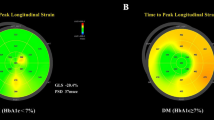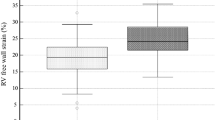Abstract
Left ventricular (LV) function undergoes subtle changes (subclinical left ventricular dysfunction) in a large proportion of patients with type 2 diabetes (T2DM) who develop diabetic cardiomyopathy. This study aimed to quantify LV myocardial strain and synchrony in T2DM by real-time three-dimensional echocardiography (RT-3DE), and to evaluate subclinical LV dysfunction in T2DM at different glycemic control levels. Seventy-two patients with T2DM with an LV ejection fraction (LVEF) ≥ 55% and 45 healthy individuals as controls who underwent RT-3DE were studied. Patients were also subdivided into the DMa group (glycosylated hemoglobin < 7%, n = 38) and the DMb group (glycosylated hemoglobin ≥ 7%, n = 34). Three-dimensional strain and synchronization parameters of the left ventricle were measured by RT-3DE and compared among the three groups. Despite a similar LVEF, global longitudinal strain (GLS), global circumferential strain (GCS), and global area strain (GAS) in the DMb group were lower, and the standard deviation of peak time (Tm-SD) and the maximum difference in peak time (Tm-Dif) in the DMb group higher, than those in the control and DMa groups (all p < 0.05). Multivariable linear regression analysis showed that the duration of diabetes was independently associated with GCS (β = − 0.516, p < 0.001) and GAS (β = − 0.391, p = 0.005). HbA1c levels were independently associated with GLS (β = − 0.675, p < 0.001), Tm-SD (β = 3.363, p < 0.001), and Tm-Dif (β = 3.895, p < 0.001). RT-3DE can detect subclinical myocardial dysfunction in poor glycemic control of T2DM, and myocardial dysfunction is associated with the duration of diabetes and HbA1c.


Similar content being viewed by others
References
Tadic M, Ilic S, Cuspidi C, Stojcevski B, Ivanovic B, Bukarica L, Jozika L, Celic V (2015) Left ventricular mechanics in untreated normotensive patients with type 2 diabetes mellitus: a two- and three-dimensional speckle tracking study. Echocardiography 32(6):947–955
Amos AF, McCarty DJ, Zimmet P (1997) The rising global burden of diabetes and its complications: estimates and projections to the year 2010. Diabet Med 5:S1–85
Boudina S, Abel ED (2007) Diabetic cardiomyopathy revisited. Circulation 115:3213–3223
Aneja A, Tang WH, Bansilal S, Garcia MJ, Farkouh ME (2008) Diabetic cardiomyopathy: insights into pathogenesis, diagnostic challenges, and therapeutic options. Am J Med 121:748–757
Von Bibra H, St John Sutton M (2010) Diastolic dysfunction in diabetes and the metabolic syndrome: promising potential for diagnosis and prognosis. Diabetologia 53:1033–1045
Larghat AM, Swoboda PP, Biglands JD, Kearney MT, Greenwood JP, Plein S (2014) The microvascular efects of insulin resistance and diabetes on cardiac structure, function, and perfusion: a cardiovascular magnetic resonance study. Eur Heart J Cardiovasc Imaging 15:1368–1376
Di Carli MF, Janisse J, Grunberger G, Ager J (2003) Role of chronic hyperglycemia in the pathogenesis of coronary microvascular dysfunction in diabetes. J Am Coll Cardiol 41:1387–1393
Luis SA, Yamada A, Khandheria BK, Speranza V, Benjamin A, Ischenko M, Platts DG, Hamilton-Craig CR, Haseler L, Burstow D et al (2014) Use of three-dimensional speckle-tracking echocardiography for quantitative assessment of global left ventricular function: a comparative study to three-dimensional echocardiography. J Am Soc Echocardiography 27:285–291
Tops LF, Delgado V, Marsan NA, Bax JJ (2017) Myocardial strain to detect subtle left ventricular systolic dysfunction. Eur J Heart Fail 19(3):307–313
Ernande L, Bergerot C, Rietzschel ER, De Buyzere ML, Thibault H, Pignonblanc PG, Croisille P, Ovize M, Groisne L, Moulin P et al (2011) Diastolic dysfunction in patients with type 2 diabetes mellitus: is it really the first marker of diabetic cardiomyopathy? J Am Soc Echocardiography 24:1268–1275
Smiseth OA, Torp H, Opdahl A, Haugaa KH, Urheim S (2016) Myocardial strain imaging: how useful is it in clinical decision making? Eur Heart J 37:1196–1207
Khan SG, Klettas D, Kapetanakis S, Monaghan MJ (2016) Clinical utility of speckle-tracking echocardiography in cardiac resynchronisation therapy. Echo Res Pract 3(1):R1–R11. https://doi.org/10.1530/ERP-15-0032
American Diabetes Association (2012) Standards of medical care in diabetes—2012. Diabetes Care 35(suppl):S11–63
Nakai H, Takeuchi M, Nishikage T, Lang RM, Otsuji Y (2009) Subclinical left ventricular dysfunction in asymptomatic diabetic patients assessed by two-dimensional speckle tracking echocardiography: correlation with diabetic duration. Eur J Echocardiogr 10:926–932
Ng AC, Delgado V, Bertini M, van der Meer RW, Rijzewijk LJ, Shanks M, Nucifora G, Smit JW, Diamant M, Romijn JA et al (2009) Findings from left ventricular strain and strain rate imaging in asymptomatic patients with type 2 diabetes mellitus. Am J Cardiol 104:1398–1401
Wang Q, Tan K, Xia H, Gao Y (2018) Left ventricular structural alterations are accompanied by subclinical systolic dysfunction in type 2 diabetes mellitus patients with concomitant hyperlipidemia: an analysis based on 3D speckle tracking echocardiography. Echocardiography 35:965–974
Li ZJ, Du LF, Luo XH (2014) Evaluation of ventricular-vascular coupling in patients with type 2 diabetes mellitus using 2-dimensional speckle tracking imaging. Huazhong Univ Sci Technolog Med Sci 34:929–934
Wang Q, Ma W, Xia J (2018) Nonalcoholic fatty liver is associated with further left ventricular abnormalities in patients with type 2 diabetes mellitus: a 3-dimensional speckle-tracking study. J Ultrasound Med 37:1899–1911
Truong VT, Phan HT, Pham KNP, Duong HNH, Ngo TNM, Palmer C et al (2019) Normal ranges of left ventricular strain by three-dimensional speckle-trackingechocardiography in adults: a systematic review and meta-analysis. J Am Soc Echocardiogr 32(12):1586–1597
Seo Y, Ishizu T, Aonuma K (2014) Current status of 3-dimensional speckle tracking echocardiography: a review from our experiences. J Cardiovasc Ultrasound 22:49–57
Xu TY, Sun JP, Lee AP, Yang XS, Qiao Z, Luo X et al (2014) Three-dimensional specklestrain echocardiography is more accurate and efficient than2Dstrain in the evaluation of left ventricular function. Int J Cardiol 176:360–366
Zhang X, Wei X, Liang Y, Liu M, Li C, Tang H (2013) Differential changes of left ventricular myocardial deformation in diabetic patients with controlled and uncontrolled blood glucose: a three-dimensional speckle-tracking echocardiography-based study. J Am Soc Echocardiogra 26:499–506
Yoshifumi S (2015) β-cell dysfunction: its critical role in prevention and management of type 2 diabetes. World J Diabetes 6(1):109–124
Mannucci E, Monami M, Dicembrini I, Piselli A, Porta M (2014) Achieving HbA1c targets in clinical trials and in the real world: a systematic review and meta-analysis. J Endocrinol Invest 37(5):477–495. https://doi.org/10.1007/s40618-014-0069-6
Iribarren C, Karter AJ, Go AS, Ferrara A, Liu JY, Sidney S, Selby JV (2001) Glycemic control and heart failure among adult patients with diabetes. Circulation 103:2668–2673
Stratton IM, Adler AI, Neil HA, Matthews DR, Manley SE, Cull CA, Hadden D, Turner RC, Holman RR (2000) Association of glycaemia with macrovascular and microvascular complications of type 2 diabetes (UKPDS 35): prospective observational study. BMJ 321:405–412
Jia G, Whaley-Connell A, Sowers JR (2018) Diabetic cardiomyopathy: a hyperglycaemia- and insulin-resistance-induced heart disease. Diabetologia 61(1):21–28. https://doi.org/10.1007/s00125-017-4390-4
Frustaci A, Kajstura J, Chimenti C, Jakoniuk I, Leri A, Maseri A, Nadal-Ginard B, Anversa P (2000) Myocardial cell death in human diabetes. Circ Res 87:1123–1132
Cai L, Wang Y, Zhou G, Chen T, Song Y, Li X, Kang YJ (2006) Attenuation by metallothionein of early cardiac cell death via suppression of mitochondrial oxidative stress results in a prevention of diabetic cardiomyopathy. J Am Coll Cardiol 48:1688–1697
Zhao XY, Hu SJ, Li J, Mou Y, Chen BP, Xia Q (2006) Decreased cardiac sarcoplasmic reticulum Ca2+-ATPase activity contributes to cardiac dysfunction in streptozotocin-induced diabetic rats. J Physiol Biochem 62:1–8
Taegtmeyer H, McNulty P, Young ME (2002) Adaptation and maladaptation of the heart in diabetes, part I. Circulation 105:1727–1733
An D, Rodrigues B (2006) Role of changes in cardiac metabolism in development of diabetic cardiomyopathy. Am J Physiol Heart Circ Physiol 291:H1489–H1506
Aon MA, Foster DB (2015) Diabetic cardiomyopathy and the role of mitochondrial dysfunction: novel insights, mechanisms, and therapeutic strategies. Antioxid Redox Signal 22(17):1499–1501. https://doi.org/10.1089/ars.2015.6349
Funding
This research received no external funding.
Author information
Authors and Affiliations
Contributions
Conceptualization, XC; methodology, XC; echocardiographic imaging analysis, XC and QY; data curation, XC and QY; writing-original draft preparation, XC; writing-review and editing, XC, HG, QY, JF and XK.
Corresponding author
Ethics declarations
Conflict of interest
The authors declare no conflict of interest.
Additional information
Publisher's Note
Springer Nature remains neutral with regard to jurisdictional claims in published maps and institutional affiliations.
Rights and permissions
About this article
Cite this article
Chen, X., Guo, H., Yang, Q. et al. Quantitative evaluation of subclinical left ventricular dysfunction in patients with type 2 diabetes mellitus by three-dimensional echocardiography. Int J Cardiovasc Imaging 36, 1311–1319 (2020). https://doi.org/10.1007/s10554-020-01833-5
Received:
Accepted:
Published:
Issue Date:
DOI: https://doi.org/10.1007/s10554-020-01833-5




